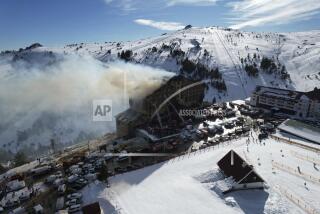Just the Right Touch for Hotel Fire Safety System
- Share via
Fire safety systems at hotels don’t necessarily need an electronic or high-tech basis to be effective. A growing number of hotels are employing a touch system that helps guests flee fires.
The system is based on a series of plaques with raised metal arrows bearing indicator bumps. Placed on walls in corridors, hallways, stairways and landings, these arrows help indicate in which direction and how far away the closest exit is.
The number of indicator bumps on an arrow tell how many doors one has to pass before reaching an exit; the bumps keep decreasing as you get closer to the evacuation point.
Feeling a plaque with a simple cross means that the exit is directly across the corridor. And if you feel the word “exit” on the plaque, you know you’ve reached the exit door.
Another set of indicator bumps, installed in stairways, can lead you down the stairs to the ground level. Again, the number of bumps on the plaques tells how many floors to go before you reach the ground floor.
Doorknob Height
The exit arrows are generally placed at doorknob height, so people in wheelchairs can also use them. But as an additional measure, a second set of arrows is placed at crawling height, about a foot off the floor.
Some hotels are placing charts of this system in their rooms to alert guests.
The touch system helps guests especially when electricity is out and halls and stairways are plunged into darkness. The system should also help when a floor is filled with smoke.
This touch method is expected to be of help to people who are handicapped, including those who can’t hear warning phone calls or other messages, very young guests and those who simply don’t understand any signs in local languages.
While most hotels, spurred by stringent fire codes, have installed fire/smoke detectors and sprinkler systems, these are by no means foolproof. And even if a detector alerts you to fire and/or smoke relatively early, being able to quickly reach a safe exit point is still vital.
“About 20 to 30 hotels in the United States are using this product now,” says Larry Chervenak, president of Chervenak, Keane & Co., a consulting firm that publishes a newsletter on hotel technology. “There should be a slow but steady growth of its use until some jurisdiction makes it mandatory, and then other areas will jump on the bandwagon.”
Detroit Hotel Was First
The 225-room Hotel St. Regis in Detroit is credited with being the first property to install the system. “The guest response has been very favorable, with people agreeing that this is an extra measure of safety,” says Chris Michels, rooms manager.
Meanwhile, a struggle is under way on whether the federal government or state, county or city authorities should establish fire safety rules for the lodging industry. State and local authorities handle this aspect now, but there is considerable support for the federal government to become more involved.
The House of Representatives has a bill pending--the Hotel & Motel Fire Safety Act--that gives the U.S. Fire Administration nine months to establish guidelines for sprinklers in all lodging places having three or more stories, and for smoke detectors in units with more than four rooms.
Subsequently, states would have one year after the creation of these guidelines to inform the USFA which hotels and motels in their area meet these new fire safety requirements.
More Laws Coming
“This bill may still be amended, but something will probably be passed,” Chervenak says. “One of the issues is whether sprinklers should be mandatory in all guest rooms or just those over a certain level, such as 75 feet, which is the general cutoff point beyond which fire-fighting equipment won’t reach.”
Several states, as well as counties and cities, have tightened their rules. For example, Massachusetts and Puerto Rico have passed legislation requiring more extensive use of sprinkler systems in guest rooms.
“Nine or 10 other states are actively considering such legislation or new codes calling for use of sprinklers,” Chervenak says. However, he added, there is a substantial inconsistency in the requirements among the different state, county and municipal codes.
Hotel chains are also tightening their rules. For example, by the end of this year every Hilton-owned as well as Hilton franchise hotel will need to either have sprinklers in the rooms or install a central communications system linking in-room smoke detectors to the front desk, according to Tom Daly, director of life safety for the Hilton chain. “The overwhelming majority of properties has completed this process already,” Daly said.
Central Control
“Having the detectors linked to a central communications system is very important, since guests may not be in a room when smoke develops and the maids may not be around or hear the detector go off,” Chervenak says. “Meanwhile, the smoke or fire can quickly spread through air-conditioning ducts or toilet exhausts to other rooms.”
Chervenak added that while a majority of U.S. hotels has smoke detectors, only a small percentage communicates alarms on a central basis. “Use of centrally communicated smoke detector systems is one of the areas of fire protection at hotels that’s going to really grow,” he predicted.
While use of flame-retardant materials has also grown, there is still no generally accepted test for toxicity arising from the two most likely elements to be ignited: mattresses and upholstered material, Daly said. “It will be a few years before we see such a toxicity test developed. However, a functional sprinkler system in the room will remove the risk of any life-threatening levels of toxicity.”
More to Read
Sign up for The Wild
We’ll help you find the best places to hike, bike and run, as well as the perfect silent spots for meditation and yoga.
You may occasionally receive promotional content from the Los Angeles Times.






